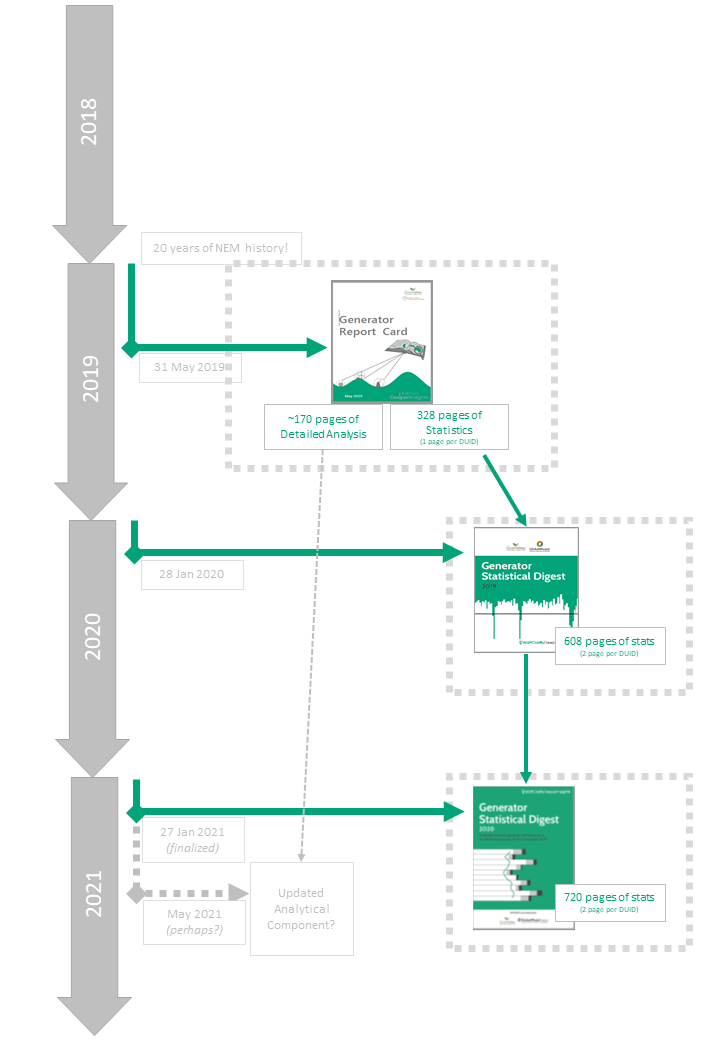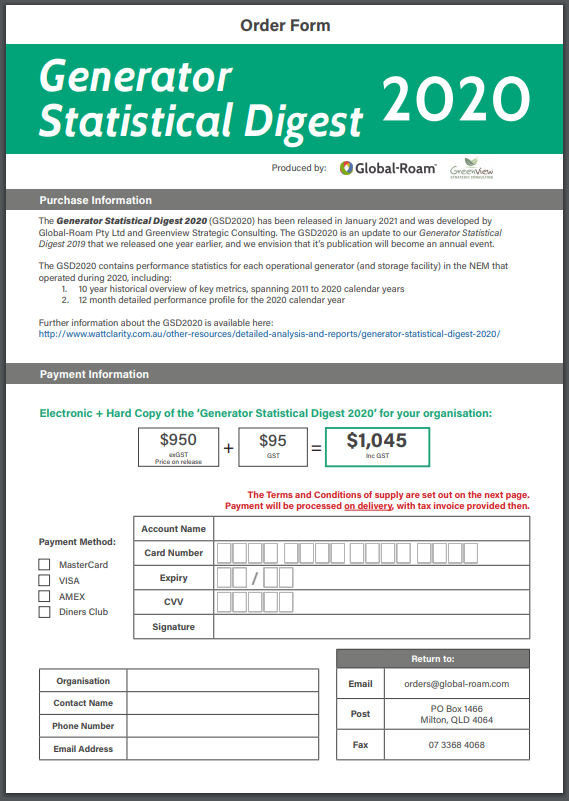Our(note D1) Generator Report Card 2018, and the Generator Statistical Digest 2019 that followed it, have both been wonderfully successful(note D2). We appreciate all the feedback we have received in the growing number of months since then!
One of the most common requests we have received has been about updates, which we are addressing as illustrated here:
Beginning with our(note D1) GSD2019, and then continuing with this Generator Statistical Digest 2020, we aim to be publishing an annual Statistical Digest which will continue to evolve as the National Electricity Market evolves, and will provide a particular focus to performance metrics for the generation sector in the past year.
For instance in the next update, we understand it will need to reflect two significant changes that will occur in the market in October 2021 – the advent of Five Minute Settlement, and the inception of the Wholesale Demand Response Mechanism.
(A) Building on the GRC2018
The GRC2018 was structured to contain two core components of value:
Component #1 was ~180 pages of Detailed Analysis; whilst
Component #2 was 328 pages in what we took to calling a Generator Statistical Digest (i.e. part 3 in the Report Card).
This is illustrated here:
Both components in the GRC2018 delivered significant value in different ways:
| ~180 pages of Detailed Analysis | 328 pages of DUID-per-page Statistics |
| In this component we invested a gargantuan number of hours in completing a series of overlapping analytical projects to deliver discrete pieces of insight.
This was a time-intensive process that focused the analysis on what we saw as some of the most important aspects of this energy transition.
|
In contrast, the statistical digest was (almost) automatically generated with operational data over the 10 year period (from 1st January 2009 through until 31st December 2018).
This was only possible after a parallel investment of a mammoth number of hours: |
Hence it was logical for us(note D1) to decide to update each component separately, moving forwards:
| … updating the Detailed Analytical Component?
(perhaps later in 2021) |
…updating the DUID-per page Statistical Component
(we’ve done this) |
| To update this analysis would necessarily mean extending it deeper/further than what we delivered in the GRC2018.
This will take a substantial commitment of time. We certainly understand a number of areas in which we would like to drive the analysis further: ———————- It is likely that these analytical exercises might be a couple years in part – to allow for both: 1) Sufficient time to elapse to ensure the market was presenting enough new challenges worthy of deeper analysis; and also 2) To allow us to have sufficient bandwidth to make the substantial investment of time required. |
In comparison (in theory, at least), we thought it would be relatively quick to update what we did for Part 3 of the Generator Report Card, and provide that separately as an update under a different name to differentiate.
Given the nature of the people we are, we’d not be happy to do just that, however. Instead, we decided to invest more time into the development of a new product out of what we did in Part 3 of the Report Card: The GSD2019 was borne from this … and has continued (with some upgrades) into the GSD2020. |
So, following from the above train of thought, we emerged at a design for a Generator Statistical Digest enabling release on 28th January 2020 (only 4 weeks after the end of the year in focus).
(B) What the Generator Statistical Digest 2020 is…
Following discussions internally (and with some clients – thanks!), we settled on a design that started with what we completed for Part 3 in the GRC2018 – but extended it in three key ways for the GSD2019:
| GSD2019 Date Range | GSD2019 DUID list | GSD2019 ‘two pages per DUID’ |
| The page we have already designed is focused on the most recent 10-year range.
It’s logical for this to cover the period 2010-2019 with data till 31st December 2019. We’ve called this the ‘A’ Page. |
Of course, part of the value of this product would be that it included stats for units that only began operations in 2019.
Because we’re thinking of extending this to two-pages-per-DUID we propose to also drop any older unit not operational in 2019 (e.g. no pages for Hazelwood). |
Extending to two pages per DUID we have added in a ‘B’ Page.
This gave us a chance to focus on producing useful metrics that would bring us one step closer to answering new questions we have been pondering. These questions have arisen as a result of any or all of the following: |
We then started with the template for the GSD2019 and updated as follows for the GSD2020:
| GSD2020 Date Range | Updating the DUID list | Extending to 2 pages with a focus on 2019 |
| We shifted the context of the ‘A’ Page to have it span the period:
1) From January 2011 2) Until December 2020. |
We continued the method used for the GSD2019, by focusing on units (i.e. DUIDs) that were operational at some point in 2020.
This means that the number of units, in total, increased from 304 to 330 units because of: 1) The influx of new entrants over the 2020 year; and also 2) The fact that there were a couple older units that did not operate at all in 2020 – such as some Torrens A units. |
As with the GSD2019 this new Digest contains both an ‘A’ Page (10-year focus) and a ‘B’ Page (detailed monthly stats for 2020).
|
(C) Order your copy of the GSD2020 today!
You’re all welcome to order your copy of the Generator Statistical Digest 2020 using this Order Form:
We look forward to hearing from you.
(D) Other notes
Other notes, as tagged above:
(D1) Who’s the “we” who prepared the GSD2020
As with the GRC2018 and GSD2019 that came before this, the Generator Statistical Digest 2020, this was a collaborative effort. We appreciate the collaboration!
(D2) How do we measure the prior success of the GRC2018 and GSD2019
The GRC2018 has been wonderfully successful (even into 2021, we have continued receiving orders for the GRC2018 – released 31st May 2019). The follow-on GSD2019 was also successful – and certainly one factor that has led to us taking the next step in making the Generator Statistical Digest an annual publication.
However it’s also more than that…
When we speak of “the success” of the GRC2018/GSD2019, there are a number of specific points of feedback we are speaking about, including these:
1) They have been widely purchased and read across the Australian energy sector (wholesale participants, but also a diverse range of other stakeholders).
2) We have been inundated with favourable feedback from those who have purchase either, or (commonly) both documents. Only a couple days after release of the GRC2018 on 31st May 2019 we summarised some early GRC2018 feedback here, and it has continued to flow in over many months.
3) One of the most common questions we’ve been asked is when we would consider updating the report – and whether it might be a regular publication in future. Being on the end of a regular stream of feedback like this helps to reinforce our sense of success.
4) However perhaps the greatest measure of success, for us, is that the GRC2018 (and also the GSD2019) makes it much, much easier for to answer questions (and a diverse range of them!) about the performance of generation assets in the NEM. The GSD2020 will also help us with that!



